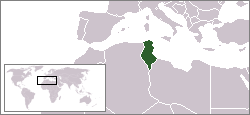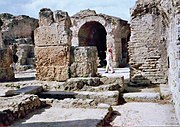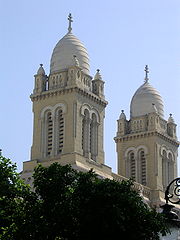Tunisia
From Wikipedia, the free encyclopedia.
|
|||||
| National motto: n/a | |||||
 |
|||||
| Official language | Arabic | ||||
| Capital | Tunis | ||||
| President | Zine El Abidine Ben Ali | ||||
| Prime Minister | Mohamed Ghannouchi | ||||
| Area - Total |
Ranked 89th 163,610 km² |
||||
| Population - Total (2005) |
Ranked 80th 10,074,951 |
||||
| Currency | Tunisian dinar | ||||
| Time zone - in summer |
CET (UTC+1) CEST (UTC+2) |
||||
| Independence - Granted |
(from France) March 20, 1956 |
||||
| National anthem | Himat Al Hima | ||||
| Internet TLD | .tn | ||||
| Calling Code | 216 | ||||
The Tunisian Republic (الجمهرية التونسية), or Tunisia, is a Muslim Arab country situated on the North African Mediterranean coast. It is the easternmost and smallest of the nations situated along the Atlas mountain range, bordering Algeria, to the west, and Libya to the south and east. Forty percent of the country is comprised by the Sahara desert, with much of the remainder consisting of particularly fertile soil, with easily accessible coasts. Both played a prominent role in ancient times, first with the famous Phoenician city of Carthage, and later, as the Africa Province, it became known as the bread basket of the Roman Empire. It is thought that the name Tunis originated from Berber, meaning either a geographical promontory, or, "to spend the night."
Contents |
History
Main article: History of Tunisia


At the beginning of recorded history, Tunisia was inhabited by Berber tribes. Its coast was settled by Phoenicians starting as early as the 10th Century B.C. In the 6th Century B.C., Carthage rose to power, but it was conquered by Rome (2nd Century B.C.), and the region became one of the granaries of Rome. It was held by the Vandals (5th cent. A.D.) and Byzantines (6th Century). In the 7th Century it was conquered by Arab Muslims, who founded Al Qayrawan. Successive Muslim dynasties ruled, interrupted by Berber rebellions. The reigns of the Aghlabids (9th Century) and of the Zirids (from 972), Berber followers of the Fatimids, were especially prosperous. When the Zirids angered the Fatimids in Cairo (1050), the latter sent in the Banu Hilal to ravage Tunisia. The coasts were held briefly by the Normans of Sicily in the 12th Century. In 1159, Tunisia was conquered by the Almohad caliphs of Morocco. They were succeeded by the Berber Hafsids (c.1230–1574), under whom Tunisia prospered. In the last years of the Hafsids, Spain seized many of the coastal cities, but these were recovered for Islam by the Ottoman Empire. Under its Turkish governors, the Beys, Tunisia attained virtual independence. The Hussein dynasty of Beys, established in 1705, lasted until 1957. In the late 16th Century the coast became a pirate stronghold (see: Barbary States). It was made a French protectorate on May 12, 1881. Tunisia became independent in 1956, and has had two presidents since.
Politics
Main article: Politics of Tunisia
Tunisia is a republic with a strong presidential system dominated by a single political party.
President Zine El Abidine Ben Ali has been in office since 1987 when he deposed Habib Bourguiba, who had been President since Tunisia's independence from France in 1956. The ruling party, the Democratic Constitutional Rally (RCD), was the sole legal party for 25 years--when it was known as the Socialist Destourian Party (PSD) - and still dominates political life .
The President is elected to 5-year terms - with virtually no opposition - and appoints a Prime Minister and cabinet, who play a strong role in the execution of policy. Regional governors and local administrators also are appointed by the central government; largely consultative mayors and municipal councils are elected.
There is a unicameral legislative body, the Chamber of Deputies, which has 182 seats, 20% of which are reserved for the opposition. It plays a growing role as an arena for debate on national policy but never originates legislation and virtually always passes bills presented by the executive with only minor changes.
The judiciary is nominally independent but responds to executive direction especially in political cases. The military is professional and does not play a role in politics. There are currently six legal opposition parties.
Tunisia is going for its Municipal Elections in May 2005.
See also:
Governorates
Main article: Governorates of Tunisia
Tunisia is subdivided into 24 governorates.
Geography
Main article: Geography of Tunisia
Tunisia is in north Africa, between the Mediterranean Sea and the Sahara Desert and between Algeria and Libya. Much of the land is semi-arid and desert. There are mountains in the north. The climate is temperate in the north, with mild, rainy winters and hot, dry summers. The desert is in the south.
See also:
Economy
Main article: Economy of Tunisia
Tunisia has a diverse economy, with important agricultural, mining, energy, tourism, and manufacturing sectors. Governmental control of economic affairs while still heavy has gradually lessened over the past decade with increasing privatization, simplification of the tax structure, and a prudent approach to debt. Real growth averaged 5.0% in the 1990s, and inflation is slowing. Growth in tourism and increased trade have been key elements in this steady growth. Tunisia's association agreement with the European Union (EU) entered into force on March 1, 1998, the first such accord between the EU and Mediterranean countries to be activated. Under the agreement Tunisia will gradually remove barriers to trade with the EU over the next decade. Broader privatization, further liberalization of the investment code to increase foreign investment, and improvements in government efficiency are among the challenges for the future. In 2008, Tunisia will be a completely associated member of the E.U. (comparable to the status of Norway or Iceland).
Culture of Tunisia
Main article: Culture of Tunisia
See also:
Demographics of Tunisia
Main article: Demographics of Tunisia
Modern Tunisians are the descendants of indigenous Berbers and of people from numerous civilizations that have invaded, migrated to, and been assimilated into the population over the millennia. Recorded history in Tunisia begins with the arrival of Phoenicians, who founded Carthage and other North African settlements in the 8th century BC. Carthage became a major sea power, clashing with Rome for control of the Mediterranean until it was defeated and captured by the Romans in 146 B.C. The Romans ruled and settled in North Africa until the 5th century when the Roman Empire fell and Tunisia was invaded by European tribes, including the Vandals. The Muslim conquest in the 7th century transformed Tunisia and the make-up of its population, with subsequent waves of migration from around the Arab and Ottoman world, including significant numbers of Spanish Moors and Jews at the end of the 15th century. Tunisia became a center of Arab culture and learning and was assimilated into the Turkish Ottoman Empire in the 16th century. It was a French protectorate from 1881 until independence in 1956, and retains close political, economic, and cultural ties with France.
Nearly all Tunisians (98% of the population) are Muslim. There has been a Jewish population on the southern island of Djerba for 2000 years, and there remains a small Jewish population in Tunis which is descended from those who fled Spain in the late 15th century. There is no indigenous Christian population. Small nomadic indigenous minorities have been mostly assimilated into the larger population.
Education
Main article: List of universities in Tunisia Colleges and universities in Tunisia include:
- International University of Tunis
- Universite Libre de Tunis
- University of Aviation and Technology, Tunisia
Miscellaneous Topics
- Communications in Tunisia
- History of the Jews in Tunisia
- Military of Tunisia
- Transportation of Tunisia
External links
Government
- Tunisia Government official site (French)
- Tunisia Chamber of Deputies official site (Arabic)
News
- AllAfrica.com - Tunisia news headline links
- Tunisia Media Online government-sourced
- The North Africa Journal business news
Overviews
Tourism
Other
- Nawaat
- Tunisian online demonstration as protest against dictatorship
- For the liberation of Political Prisoners in Tunisia
- TunisiaOnline
- The tunisian law from Jurispedia
- Tunisia Daily
| Arab League | |
|---|---|
| Algeria | Bahrain | Comoros | Djibouti | Egypt | Iraq | Jordan | Kuwait | Lebanon | Libya | Mauritania | Morocco | Oman | State of Palestine | Qatar | Saudi Arabia | Somalia | Sudan | Syria | Tunisia | United Arab Emirates | Yemen | |
| Countries in Africa | ||
|
Algeria | Angola | Benin | Botswana | Burkina Faso | Burundi | Cameroon | Cape Verde | Central African Republic | Chad | Comoros | Democratic Republic of the Congo | Republic of the Congo | Côte d'Ivoire | Djibouti | Egypt | Equatorial Guinea | Eritrea | Ethiopia | Gabon | The Gambia | Ghana | Guinea | Guinea-Bissau | Kenya | Lesotho | Liberia | Libya | Madagascar | Malawi | Mali | Mauritania | Mauritius | Morocco | Mozambique | Namibia | Niger | Nigeria | Rwanda | São Tomé and Príncipe | Senegal | Seychelles | Sierra Leone | Somalia/Somaliland | South Africa | Sudan | Swaziland | Tanzania | Togo | Tunisia | Uganda | Western Sahara/SADR | Zambia | Zimbabwe |
||
| Dependencies: British Indian Ocean Territory | Canary Islands | Ceuta and Melilla | Madeira Islands | Mayotte | Réunion | Saint Helena and dependencies | ||
| Countries in the Mediterranean |
|---|
| Albania | Algeria | Bosnia and Herzegovina | Croatia | Cyprus | Egypt | France | Greece | Israel | Italy | Lebanon | Libya | Malta | Monaco | Morocco | Serbia and Montenegro | Slovenia | Spain | Syria | Tunisia | Turkey |









.jpg/180px-Tabouna_(Piotr_Kuczynski).jpg)






